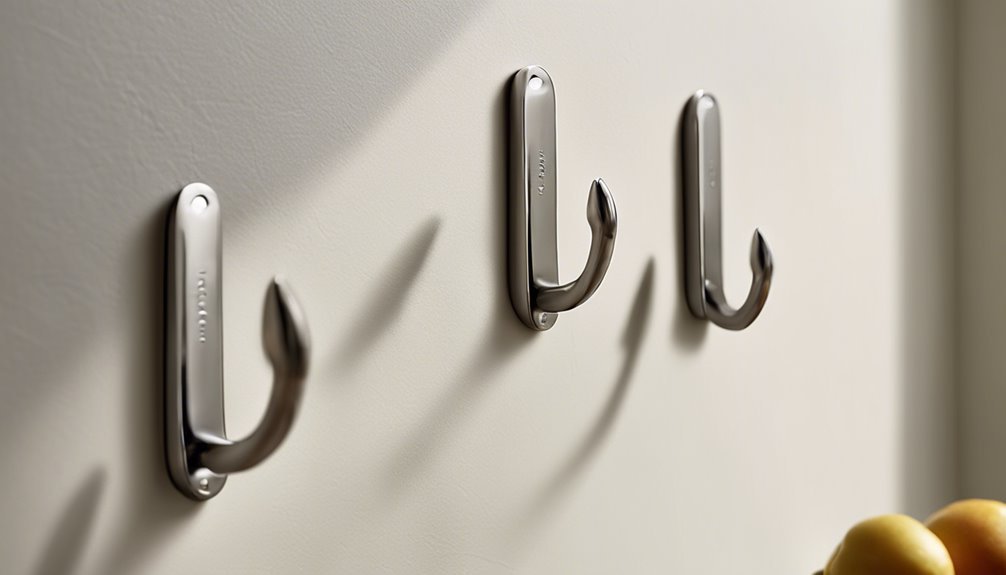Command Hooks vs. Regular Hooks
When choosing between command hooks and regular hooks, consider your needs. Command hooks are easy to install, damage-free, and perfect for lightweight items, making them great for renters. However, they only support lighter weights. On the other hand, regular hooks are durable and can hold heavy items but might cause wall damage. Depending on your situation, one may suit you better than the other. Explore more to find the best choice for your space.
Overview of Command Hooks
When you need a versatile solution for hanging items without damaging your walls, Command Hooks are a game-changer. Made from durable command hook materials, these hooks come in various sizes and styles to suit any need. Their unique adhesive strength guarantees they hold securely while being easy to remove without leaving residue. Whether you're hanging artwork, holiday decorations, or organizational tools, Command Hooks provide the freedom to rearrange your space effortlessly. You don't have to worry about nails or screws; just peel, stick, and hang! With a simple application process, you can transform your walls into a functional display area. Embrace the flexibility of Command Hooks and enjoy a clutter-free environment without the stress of permanent damage.
Benefits of Command Hooks
When you're looking for a hassle-free way to hang items, Command Hooks really shine. Their easy installation means you won't need any tools, and when it's time to remove them, you won't damage your walls. Plus, their versatility lets you use them in various spaces, from kitchens to bathrooms and beyond.
Easy Installation Process
One of the standout advantages of Command Hooks is their incredibly easy installation process. You won't need special tools or complicated installation techniques—just peel, stick, and hang! It's that simple. Plus, with minimal surface preparation, you can transform your space in minutes.
Here's a quick comparison of installation steps:
| Step | Command Hooks |
|---|---|
| 1. Clean Surface | Use rubbing alcohol |
| 2. Peel Back Liner | Remove adhesive liner |
| 3. Stick in Place | Press firmly for 30 seconds |
| 4. Wait | Let it set for an hour |
| 5. Hang Items | Attach your items with ease |
With these straightforward steps, you can enjoy a clutter-free home without the hassle. Embrace the freedom of easy decorating!
Damage-Free Removal
After enjoying the hassle-free installation of Command Hooks, you'll appreciate their damage-free removal just as much. With the right removal techniques, you can easily take them down without leaving a mark behind. Here's how to prepare your surfaces and guarantee a smooth process:
- Choose the right hook: Make sure it's suitable for your needs.
- Prepare the surface: Clean the area with isopropyl alcohol for better adhesion and removal.
- Follow the instructions: Each Command Hook comes with specific removal guidelines.
- Pull the tab slowly: Gently pull straight down to release the adhesive without damaging your wall.
Versatile Usage Options
Although you might think hooks are just for hanging items, Command Hooks offer a surprisingly wide range of versatile usage options that can transform your space. You can use them for everything from organizing your kitchen utensils to creating unique displays for your creative projects. Need to hang a wreath for the holidays? Command Hooks make it easy without damaging your walls. They're perfect for home organization—use them in closets, on doors, or even in your garage to keep items tidy and accessible. Plus, since they come in various sizes and styles, you can choose what fits your aesthetic best. Embrace your freedom to decorate and organize without limits, all while keeping your surfaces damage-free.
Limitations of Command Hooks
While Command Hooks offer a convenient solution for hanging items without damaging walls, they do come with several limitations that users should consider. Here are some key points to keep in mind:
- Durability concerns: They may not hold up under heavy or frequently moved items, leading to potential falls.
- Surface compatibility: Not all surfaces are suitable; they work best on smooth, clean areas, and may not adhere well to textured walls or certain materials.
- Temperature sensitivity: Extreme heat or cold can weaken their adhesive, affecting performance.
- Limited weight capacity: Each hook has a specified weight limit, so it's essential to check before hanging anything hefty.
Overview of Regular Hooks
When it comes to reliable hanging solutions, regular hooks stand out due to their sturdiness and versatility. You'll find various regular hook types, including wall-mounted, ceiling-mounted, and adhesive options, catering to different needs and preferences. The choice of hook material options is equally important; you can choose from metal, plastic, or wood, depending on the aesthetic and strength you're aiming for. Metal hooks are often favored for their durability, while plastic hooks can be lightweight and easy to install. Additionally, wooden hooks bring a natural touch to your decor. With so many options available, you can confidently select regular hooks that not only meet your hanging needs but also enhance your space's style and functionality.
Benefits of Regular Hooks
Regular hooks offer a myriad of benefits that make them a popular choice for both functional and decorative purposes. You'll find that they provide a robust solution for various needs, enhancing your space with ease. Here are some key advantages:
- Durability: Regular hooks are built to last, supporting heavier items without worry.
- Versatility: They're perfect for hanging art or seasonal decor, adapting to your style.
- Ease of Installation: Installing hooks is straightforward—no special tools needed.
- Aesthetic Appeal: Available in various designs, they can complement any decor while serving a practical function.
With regular hooks, you can transform your home effortlessly, allowing your creativity to flourish without constraints.
Limitations of Regular Hooks
While regular hooks can be handy, they come with some notable limitations. You might find that they can damage surfaces upon removal, and installing them isn't always a breeze. Plus, they often have strict weight limitations, which can restrict your hanging options.
Damage to Surfaces
Although many people appreciate the functionality of regular hooks, they often come at a cost to your surfaces. The damage they can cause isn't just cosmetic; it can lead to costly repairs. Here's what you should know about surface protection:
- Paint Damage: Regular hooks can peel or chip paint, leaving unsightly marks.
- Gouges and Scratches: The metal or plastic of hooks can scrape surfaces, creating permanent damage.
- Adhesive Effectiveness: When you remove a regular hook, it may not come off cleanly, pulling away layers of material.
- Residual Adhesive: Some hooks leave behind sticky residue that's tough to clean, affecting the surface's appearance.
In the pursuit of freedom in decorating, consider how regular hooks might limit your options.
Installation Difficulty
Installing regular hooks can be a frustrating experience, especially if you're not a DIY enthusiast. You'll often need to gather tools and follow specific installation techniques, which can feel overwhelming. Surface preparation is essential; if your walls aren't clean or primed properly, the hooks may not hold as expected. Drilling holes can be messy, and if you misjudge placement, you're left with unsightly marks. Aligning the hooks perfectly requires patience and can be tricky, especially in tight spaces. You might even find yourself second-guessing your decisions, which can take away from the freedom you sought in decorating. Ultimately, while regular hooks can serve a purpose, their installation demands more effort and attention than many would prefer.
Weight Limitations
When it comes to weight limitations, regular hooks can be a bit restrictive, especially if you're planning to hang heavier items. You'll notice significant weight capacity differences compared to other options, which can limit your creativity. Here are some suitable applications for regular hooks:
- Hanging lightweight frames or art (up to 5 lbs)
- Organizing kitchen utensils (up to 10 lbs)
- Displaying small plants (up to 8 lbs)
- Holding towels in the bathroom (up to 12 lbs)
If you're seeking to decorate or organize freely, these limitations can be frustrating. Consider your needs carefully; if you often hang heavier items, you might want to explore alternatives that can handle more weight without the fear of them giving way.
Comparing Weight Limits
While both command hooks and regular hooks serve the purpose of hanging items, their weight limits can vary considerably. In a weight capacity comparison, command hooks generally hold up to 5-7.5 pounds, making them ideal for lightweight decor. Regular hooks, however, can support much more, often exceeding 30 pounds, thanks to their material strength analysis, which considers the durability of metal and wood. If you're looking to hang heavier items, regular hooks are clearly the way to go. But if you value flexibility and ease of use, command hooks let you change your mind without leaving marks. Understanding these differences can help you choose the right option for your hanging needs, giving you the freedom to decorate your space as you like.
Installation and Removal
Though both command hooks and regular hooks are designed for hanging items, their installation and removal processes couldn't be more different. If you crave flexibility in your spaces, here's how they stack up:
- Installation Techniques: Command hooks require a simple peel-and-stick method, while regular hooks need nails or screws, demanding tools.
- Surface Preparation: For command hooks, clean the surface with rubbing alcohol; regular hooks just need a sturdy wall.
- Weight Limits: Command hooks are limited by adhesive strength, whereas regular hooks can typically support heavier items.
- Removal Strategies: To remove command hooks, pull the tab straight down; regular hooks require unscrewing or prying out nails, which can damage the wall.
Understanding these differences can help you choose the right hook for your needs and maintain your freedom to rearrange whenever you want!
Cost Considerations
Cost is a crucial factor when deciding between command hooks and regular hooks. While command hooks may seem pricier upfront, consider their cost effectiveness. They're designed for easy removal and won't damage your walls, which can save you money on repairs down the line. If you're a renter or frequently change your decor, these hooks offer flexibility without the hassle. Regular hooks, on the other hand, might be cheaper initially but could lead to additional costs for wall repairs or paint touch-ups. In the long run, command hooks can provide more significant long-term savings by minimizing damage and allowing you to adapt your space effortlessly. Choosing wisely between these options can keep both your walls and wallet happy!







